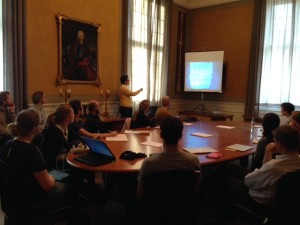Twenty scientists gathered in Copenhagen at the end of October 2015 to discuss the most recent isotope model developments and the most recent scientific understanding and interpretation of the d18O changes recorded in Greenland during the last deglaciation.
The cryosphere is in fast transition and there is the possibility that the ongoing rapid demise of Arctic sea ice may instigate abrupt changes on the Greenland Ice Sheet. Ice cores here show clear evidence of past abrupt warm events with up to 15°C warming in less than a decade, most likely triggered by rapid changes in Arctic sea ice.
These results rely heavily on oxygen isotope data, which is a key climate proxy from ice cores as well as marine sediment cores. Over the last two decades there have been a number of studies with climate models investigating the possible mechanisms behind these large changes in climate. However, comparing reconstructed climate as recorded by the oxygen isotope record with the physical climate as given by the numerical models is a challenge.
The group focused on future research priorities to answer some key questions:
- How can models help us better understand the rapid changes in d18O?
- How changes in local and non-local processes play a role in affecting the d18O recorded over Greenland during rapid abrupt cooling events?
- What are the biggest uncertainties and challenges in the isotope modelling community?
Additional key questions were:
- What was the role of sea-ice cover in affecting the d18O recorded during the D-O events?
- How the changes in sea-ice extent affect the origin of moisture delivered over Greenland?
Sensitivity studies exploring the above-mentioned aspects might be model dependent. Hence, it is important to investigate them in a multimodel framework. For this reason, a set of sensitivity studies with common boundary conditions has been defined and they will be run by 4 different modelling groups (CESM, GISS, ECHAM, HadGEM (?)). The results of these simulations will then be discussed in a future workshop within the Ice2ice project.
Author: Francesco S. R. Pausata, Department of Meteorology and Bolin Centre for Climate Research, Stockholm University, Stockholm, Sweden; email: francesco.pausata@misu.su.se
